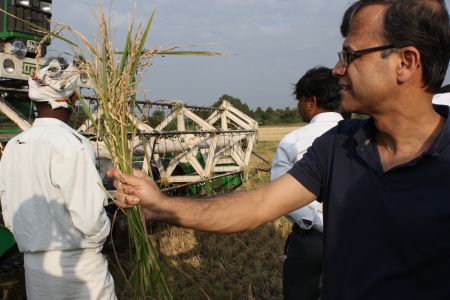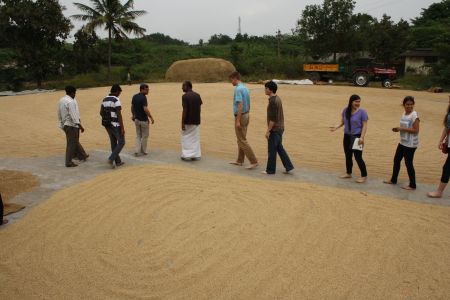by Janae Moore, Sophomore in Agricultural and Biological Engineering, Jennifer Smigielski, and Katie Saladino, Juniors in Supply Chain Management at the University of Illinois at Urbana-Champaign
The following post was written by students on an ADM Institute-sponsored observation study tour through India.
After the context we gained of agricultural production in India on Day One, we were prepared to start looking at postharvest loss issues in-depth on Day Two. An early morning start led us to the village of Kadambur, but not before we stopped along the way to observe laborers planting seedlings in a paddy field. We watched them plant by hand, noting how difficult the work seemed.

Professor Palekar shows students postharvest losses of paddy
that occur during harvest. Credit: ADM Institute/Kari Wozniak
Outside of Chennai, Kadambur is where the Marketplace Literacy Community Trust outpost is located. There we met several local representatives from different sectors, including the village president and his deputy, an extension officer, and a rice miller and trader. Our conversation focused on agriculture and how the community sustains itself with the production of crops such as paddy, groundnuts, coconut, and vegetables. When we asked about what responsibilities they have as village leaders, they told us about their work solving land disputes, implementing government acts, and improving infrastructure.
After learning about the community as a whole, we then spoke with the rice mill owner more specifically about postharvest loss. He told us about the three main causes of loss that he personally experiences–improper drying, unexpected rain, and inefficient storage facilities. He estimated that an 80 kg bag of paddy realistically yields 50 kg. We found it interesting that many farmers seem to underestimate the amount of postharvest loss they experience. A majority say that they lose anywhere from 0-10%.
The owner took us to visit his rice mill, where we saw paddy laying out to dry. He explained how if it were to rain unexpectedly, he would lose much of it. He showed us around his facility and we were impressed with the technology and processes used to fully harvest the paddy. However, we could see by simple observation that there was overlooked rice on the floor and broken rice that cannot be sold for a good price. When it comes to identifying their postharvest losses, though, many farmers wouldn’t classify this broken rice as loss because it is a quality loss, not a quantity loss.

Village rice miller shows students how paddy is dried in the open.
Credit: ADM Institute/Kari Wozniak
Afterward, we visited a larger mill owned by a different man. This second mill was more impressive than the first. While many mills have only a few machines, this mill had an eight-stage distillery process for polishing paddy into rice. The mill had a six-camera scanner that sorted the rice based on its whiteness compared to a simpler sorting system based on whether the grain is broken or not. However, despite that the second mill was more advanced, there were still apparent losses.
Late in the day, we got to observe a farmer harvesting his paddy field, which helped further our understanding of agricultural supply chains in India. Our professor pointed out that stalks are often missed by mechanical harvesting equipment that isn’t calibrated to cut the paddy a certain way. We talked about what it means to measure loss, and even did our own small experiment of counting how many paddy stalks were missed by the harvester in a 36 square foot area. We gathered over 10 stalks in that small patch of field.
Over the course of the day, we directly observed local rice production at nearly every stage. This helped us better understand the larger supply chain context of postharvest loss, and learn why losses that occur at each stage are a significant problem.
More about the trip: Illinois Students Gear up to Impact Global Food Security
Edited by: K. Wozniak and G. Kenney


No comments yet.